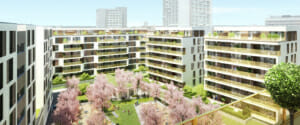Welcome to Dresden: the Zwinger Palace and the Saxony valley
Dresden – also known as Florence on the Elbe – is located in the eastern part of Germany near the boarders of the Czech Republic and Poland. The City on the river Elbe is the capital of the Free State of Saxony, more than 800 years old and enraptured with great cultural and architectural beauty. Caspar David Friedrich showed this exceptional beauty in his paintings many years ago.
However not only the city, but also the surroundings promise plenty to look at: Saxon Switzerland, the Erzgebirge, Meißen with its porcelain or the Glashütte, the centre of the European watch industry. Saxony has the largest density of castles in Germany! Should you visit Dresden you ought to take some time to visit the galleries and museums of the State Art Collections, sit by the river with the spectacular backdrop of the historic skyline, enjoy steamboat rides or walk around the Great Garden. Dresden will enchant you.
Living in Dresden: the centre and the periphery are equally good. Dresden is once again experiencing a construction boom and therefore has a much more relaxed housing market than in comparable cities. The preferred neighbourhoods are Striessen, Blasewitz, Johannstadt and Plauen.
Dresden houses some of the leading research institutes from Leibnitz to Max Planck. It is the location of the Technical University with its status of excellency. More than 100 companies including Globalfoundries, Infineon and ZMD build a consortium in microelectronics in the Saxony valley, the leading location for this sector. Countless start-ups have emerged from academic institutions such as Novaled – inventor of OLED.
Life in Dresden: Dresden is a very conservative city – yet the residents are open to new ideas.
Saxons are open-minded. They say what they think and what they don’t like, yet are friendly and likeable. The Dresdner speaks Saxon German, foreign language skills are limited.
Blue Wonder
Blue wonder is the local name for the Loschwitz bridge between Loschwitz and Blasewitz. Those looking for an apartment in Dresden won´t however need to wonder about property and rental prices. They are in compared to other German cities wonderfully reasonable! New developments rarely step over the 4,800 € mark per m2 and the rents for first time use lie around 9,00 € – 12,00 € per m2. Low tide around the river Elbe concerning the property and rental market. Welcome to Dresden!
From vacant to scarce
 Prices have however increased in the meantime. Around the year 2000 every fifth flat stood empty. Surplus characterising the market has significantly transformed to high demand – sometimes even scarcity. The mayor however reassures that they are a long way away from circumstances as critical as in Munich. The many refurbished prefabricated building blocks remain the backbone of cost-effective accommodation.
Prices have however increased in the meantime. Around the year 2000 every fifth flat stood empty. Surplus characterising the market has significantly transformed to high demand – sometimes even scarcity. The mayor however reassures that they are a long way away from circumstances as critical as in Munich. The many refurbished prefabricated building blocks remain the backbone of cost-effective accommodation.
From Blue Miracle to black hole
One must not forget though, that the people here have a lot less money in their pocket than those in Hamburg, Munich, Stuttgart and even Düsseldorf. On average a third less over the past two years. Not only the Dresden citizens have a hole in their pocket, the town has one too: the” Viennese Hole”. A huge black hole gapes next to the main railway station, an excavation pit that has, now after everyone almost coming to terms with it, been taken over by Revitalis Real Estate from Hamburg. They are building a property called “Prager Carree”, providing 241 apartments and commercial units by 2016 after the original plans to convert an office block into an opera house and shopping centre collapsed. Revitalis CEO Thomas Cromm claims; ”Dresden is one of our top-ten residential building locations in Germany.”

Abb.: 241 neue Wohnungen entstehen bis 2016 neben dem Hauptbahnhof [Fotoquelle: www.prager-carree.de]
Apartment or single-family home?
Tips for anyone preferring a single- family home are Striesen, Buelau/Weisser Hirsch, inner and outer Neustadt, Wachwitz and Tolkewitz/Seidnitz-north. Some parts of town that were anything but top addresses earlier are now catching up: Demand is rising in the Hechtviertel and in the neighbouring -just barely a harbour town- Pieschen, where rental prices have increased by 1€ per m2 and found acceptance.
Looking for an apartment in Dresden, you can be sure to find one under acceptable conditions. Even those with increased prices are still within the lower single digit range and not in the double digit area as other cities within Germany. Dresden would be well advised though to build a couple of hundred new apartments to prevent this happening. Current building is almost entirely intended for own occupancy. Rental prices for free-standing houses suffered a sharp decline in 2013, but the market has recovered. Large houses with approximately 200 m2 still remain quite reasonable due to the lack of demand. Good for anyone moving or transferring to Dresden with their family.


